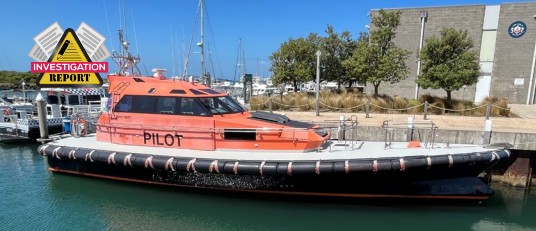The Australian Transport Safety Bureau (ATSB) published the investigation report in which, at about 1900 local time on 5 October 2023, the night shift crew (the coxswain and deckhand) of the pilot launch PV Corsair reported on duty at the launch wharf in Queenscliff harbour.
They were informed by the pilot despatch office that their first job that evening was to pick up the pilot from the outbound container ship MV Rio Grande. After preparing the launch for service, they waited in the crew quarters at the launch station. Later that evening, Rio Grande departed Melbourne with a pilot on board. It would transit Port Phillip before departing through Port Phillip Heads (the Heads).
Once the ship was clear of the entrance, the pilot would disembark onto the pilot launch and be transported back to the pilot station at Queenscliff. At about 2230, the pilot called the launch crew and advised them that Rio Grande was expected to be at the Heads at about 2300. The coxswain of Corsair reported the weather conditions to the pilot and advised that they would rendezvous with Rio Grande about 2 nautical miles (NM) offshore and to the south-west of the entrance, in relatively calmer water away from the main ebb tide. It was agreed that Rio Grande would create a lee on its starboard side for the launch to come
alongside to retrieve the pilot.
The grounding
At about 2252, Corsair met Rio Grande just inside the entrance as they proceeded outbound. At that time there was a strong ebb tide of about 5.6 knots5 and the height of tide was about 0.6 m above the charted depth. The wind was from the south-south-west direction at an average speed of 22 knots with gusts of up to 26 knots. The recorded wave height outside the Heads was about 2.4 m. Soon after passing Point Lonsdale, Rio Grande altered its course to starboard, to keep the wind and the sea on its port side, creating a lee on the starboard side to allow the pilot launch to come alongside.
Following the grounding
Several calls were made from Corsair seeking assistance, the first by mobile phone to the crew of the sister launch, PV Nepean. A Mayday distress broadcast was subsequently transmitted from Corsair on VHF radio. The distress call was heard by Ports Victoria Vessel Traffic Services (VTS) which contacted the Victoria Police Search and Rescue Squad. Victoria Police then activated the Australian Volunteer Coast Guard at Queenscliff, the Southern Peninsula Rescue Squad at Blairgowrie, and its own rescue response team. Several vessels responded to the emergency and the three occupants of Corsair were subsequently brought aboard the Coast Guard vessel at about 0132 on 6 October. They were uninjured. The pilot launch was destroyed on the reef during the night and the debris recovered the following day.
































































